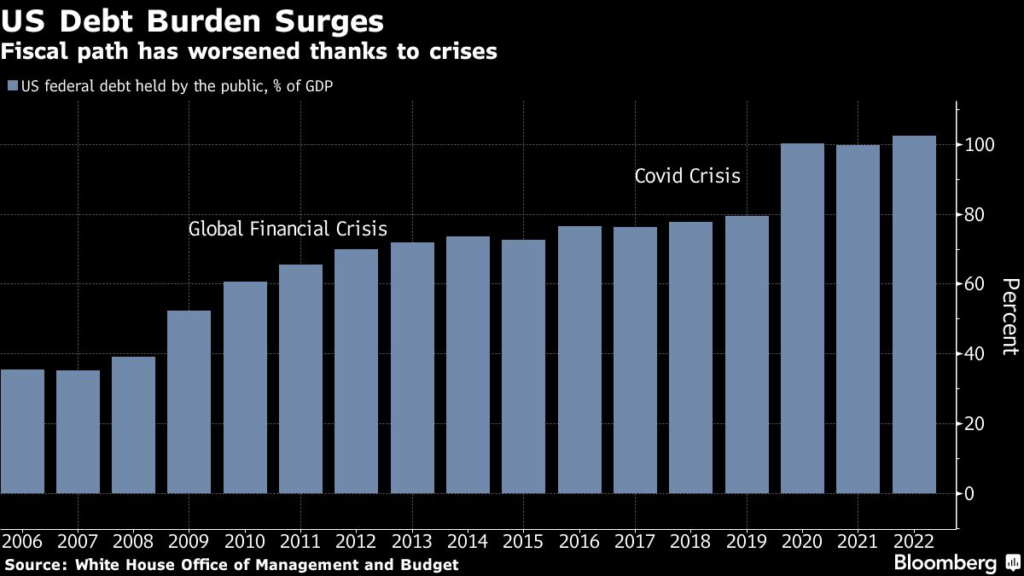Congress must raise the US federal debt ceiling by the summer or early fall in order to avoid the risk of a federal payment default, according to the widely followed Bipartisan Policy Center model.
(Bloomberg) — Congress must raise the US federal debt ceiling by the summer or early fall in order to avoid the risk of a federal payment default, according to the widely followed Bipartisan Policy Center model.
“The economic uncertainty injected into this model is significant,” said Rachel Snyderman, BPC senior associate director, in explaining the months-long range provided. “There is significant revenue volatility especially given the state of the economy.”
BPC said that if tax revenue is much lower than expected, a payment default could be triggered around June 15, before the X date range which would begin June 21.
The date represents the moment when the Treasury Department will have exhausted the potential of special accounting maneuvers to avoid breaching the debt limit. Treasury Secretary Janet Yellen advised Congress last month, when the $31.4 trillion limit was hit, that date would come sometime after the start of June.
Without congressional action, the Treasury would then no longer able meet all US payment obligations, including to bondholders, federal employees and contractors and millions of Social Security and other entitlement beneficiaries.
The estimate of the so-called X-date by the BPC, a Washington think tank, compares with a range of July to September published by the nonpartisan Congressional Budget Office last week. Goldman Sachs Group Inc. economists on Feb. 20 penciled in “early to mid-August” as their base case.
The CBO said it planned to update its analysis in May, once data on April tax payments are released.
The BPC last June had estimated the deadline at sometime after July 1, 2023.
Republicans in Congress have demanded that President Joe Biden agree to deep spending cuts in exchange for raising the debt limit. Their votes will be needed for a debt-ceiling increase or suspension to pass the Republican-controlled House and to bypass a filibuster in the Democratic-controlled Senate.
Biden has warned he won’t negotiate over the debt ceiling. But after a meeting earlier this month with Speaker Kevin McCarthy, he also said he would welcome parallel talks on the US budget. Biden plans to release a fiscal 2024 budget proposal on March 9.
House Republicans say they plan to release their own budget before April 15 detailing cuts needed to projected to eliminate annual deficits within 10 years. It would require more than $20 trillion in spending cuts if revenue weren’t increased, going by the CBO’s projections.
McCarthy has said Social Security and Medicare cuts will be off the table in the talks, making it likely the GOP will focus on anti-poverty mandatory spending programs like Medicaid and food stamps to reach a balance.
The GOP has said it will seek a $150 billion cut to a separate category of annual agency appropriations next year as part of the debt-ceiling talks. The party is divided on whether the Pentagon’s budget should be included in the reductions.
Fight Cuts
Democrats have said they will fight all such cuts. Biden has proposed increased taxes on the wealthy and corporations to help achieve a $2 trillion reduction in red ink.
The impasse elevates the risk of the debt-ceiling standoff going to the last minute or even triggering a payment default.
BPC said it is releasing the report now in order to encourage Biden and McCarthy to pick up the pace of talks.
“Our hope is that this will help spur the process,” said Shai Akabas, BPC director of economic policy.
So far, markets have shown little sign of concern, though Goldman Sachs Group Inc. analysts did find that some stocks with notable exposure to US government contracts appear to be underperforming.
“The GS basket of US stocks with at least 20% of sales tied to government spending has underperformed the S&P 500 by around 2% this year, with a large selloff on the heels of the prolonged process to elect Speaker McCarthy,” Goldman’s Tim Krupa and Alec Phillips wrote. “This likely reflects the possibility of spending cuts as part of a debt-limit compromise.”
More stories like this are available on bloomberg.com
©2023 Bloomberg L.P.










